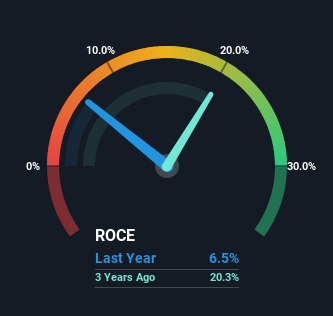The Returns On Capital At Xiamen Jihong Technology (SZSE:002803) Don't Inspire Confidence
Did you know there are some financial metrics that can provide clues of a potential multi-bagger? In a perfect world, we'd like to see a company investing more capital into its business and ideally the returns earned from that capital are also increasing. If you see this, it typically means it's a company with a great business model and plenty of profitable reinvestment opportunities. In light of that, when we looked at Xiamen Jihong Technology (SZSE:002803) and its ROCE trend, we weren't exactly thrilled.
Return On Capital Employed (ROCE): What Is It?
For those who don't know, ROCE is a measure of a company's yearly pre-tax profit (its return), relative to the capital employed in the business. To calculate this metric for Xiamen Jihong Technology, this is the formula:
Return on Capital Employed = Earnings Before Interest and Tax (EBIT) ÷ (Total Assets - Current Liabilities)
0.065 = CN¥159m ÷ (CN¥3.2b - CN¥802m) (Based on the trailing twelve months to September 2024).
Thus, Xiamen Jihong Technology has an ROCE of 6.5%. On its own that's a low return, but compared to the average of 5.2% generated by the Media industry, it's much better.
See our latest analysis for Xiamen Jihong Technology

In the above chart we have measured Xiamen Jihong Technology's prior ROCE against its prior performance, but the future is arguably more important. If you'd like to see what analysts are forecasting going forward, you should check out our free analyst report for Xiamen Jihong Technology .
So How Is Xiamen Jihong Technology's ROCE Trending?
When we looked at the ROCE trend at Xiamen Jihong Technology, we didn't gain much confidence. To be more specific, ROCE has fallen from 26% over the last five years. Given the business is employing more capital while revenue has slipped, this is a bit concerning. This could mean that the business is losing its competitive advantage or market share, because while more money is being put into ventures, it's actually producing a lower return - "less bang for their buck" per se.
On a side note, Xiamen Jihong Technology has done well to pay down its current liabilities to 25% of total assets. That could partly explain why the ROCE has dropped. What's more, this can reduce some aspects of risk to the business because now the company's suppliers or short-term creditors are funding less of its operations. Since the business is basically funding more of its operations with it's own money, you could argue this has made the business less efficient at generating ROCE.
What We Can Learn From Xiamen Jihong Technology's ROCE
From the above analysis, we find it rather worrisome that returns on capital and sales for Xiamen Jihong Technology have fallen, meanwhile the business is employing more capital than it was five years ago. Investors must expect better things on the horizon though because the stock has risen 14% in the last five years. Regardless, we don't like the trends as they are and if they persist, we think you might find better investments elsewhere.
Xiamen Jihong Technology does have some risks though, and we've spotted 3 warning signs for Xiamen Jihong Technology that you might be interested in.
While Xiamen Jihong Technology may not currently earn the highest returns, we've compiled a list of companies that currently earn more than 25% return on equity. Check out this free list here.
New: AI Stock Screener & Alerts
Our new AI Stock Screener scans the market every day to uncover opportunities.
• Dividend Powerhouses (3%+ Yield)
• Undervalued Small Caps with Insider Buying
• High growth Tech and AI Companies
Or build your own from over 50 metrics.
Have feedback on this article? Concerned about the content? Get in touch with us directly. Alternatively, email editorial-team (at) simplywallst.com.
This article by Simply Wall St is general in nature. We provide commentary based on historical data and analyst forecasts only using an unbiased methodology and our articles are not intended to be financial advice. It does not constitute a recommendation to buy or sell any stock, and does not take account of your objectives, or your financial situation. We aim to bring you long-term focused analysis driven by fundamental data. Note that our analysis may not factor in the latest price-sensitive company announcements or qualitative material. Simply Wall St has no position in any stocks mentioned.
About SZSE:002803
Xiamen Jihong
Engages in the cross-border social e-commerce and paper packaging solutions business.
Flawless balance sheet with proven track record and pays a dividend.
Market Insights
Community Narratives



